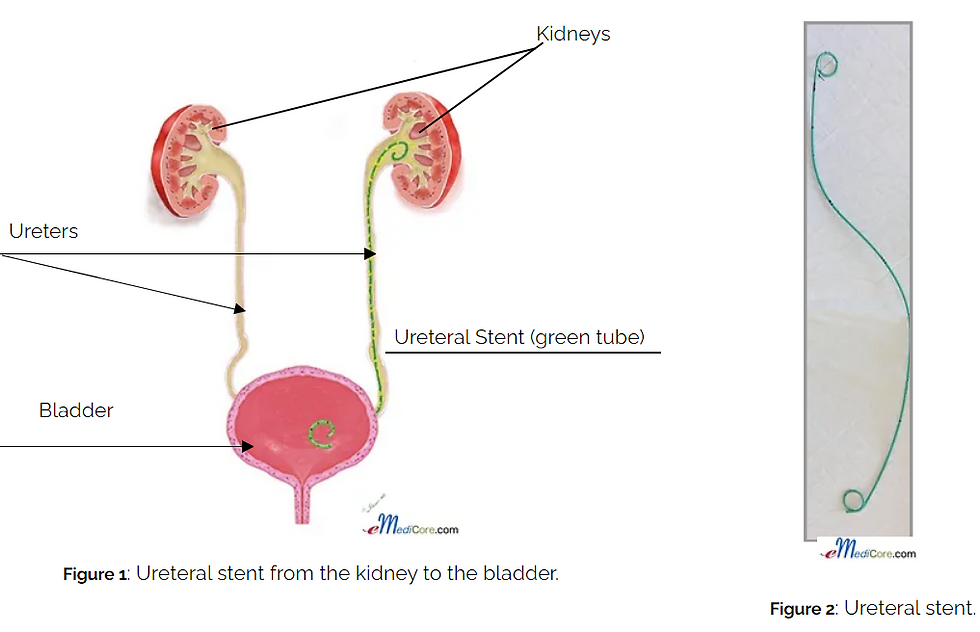Click the links below to access the video version:
What is a Ureteral Stent?
A ureteral stent is a small soft plastic tube that is placed inside a ureter, going from the kidney down to the bladder (Figure 1). One end of the stent stays in the kidney and the other end stays in the bladder. The end of the stent has a shape that curves like a J-shape. Hence, it is known as a double J-stent. Unlike a heart stent which is permanently placed inside the heart, the stent needs to be removed or replaced after a certain period of time (like weeks or months).

Why do I need a Ureteral Stent?
Indications for a ureteral stent: After certain surgical procedures on the ureters or kidneys, the ureteral stent may be placed to ensure proper drainage of urine from the kidney during the period after surgery.
A ureteral stent can be placed to relieve obstruction of the kidney due to such conditions as kidney stone or tumor in the ureter or stricture (narrowing of the ureter).
What are the Benefits of a Ureteral Stent?
It can help ensure drainage of urine from the kidneys. The ureteral stent may also help relieve pain caused by obstructions of ureter such as stone(s) in the ureter. In such circumstances, the stent stays side by side to the stone. The stent drains the urine from the kidney so that the patient may have immediate relief of pain, even though the stone may still be present in the ureter. The stent can also help the ureter heal properly after surgery or injury.
Risks or Complications of a Ureteral Stent
Some of the risks or complications of having a ureteral stent may include the stent malfunctioning, the misplacement of the stent (not in a good position). In this case, the stent can neither function nor drain the urine well. The stent may cause irritation to the bladder and the patient may have the urge to urinate often. It may also cause pain or discomfort during and shortly after urination. Furthermore, the stent may cause back pain (in the kidneys) just before, during, and after urination.
How can a Ureteral Stent cause pain in the Kidney during and after urination?
Normally, the urine flows from the kidney to the ureter down into the bladder (in a downward direction). There is a valve at the entrance of the ureter into the bladder. This valve prevents the urine from refluxing (going backward) into the kidneys when the bladder is full or during urination. In a patient who has a stent, the ureteral stent keeps that valve open, therefore preventing its closure. When the bladder is full (or during urination) the pressure is transmitted through the stent up into the kidney causing the kidney to be swollen. The patient may experience pain due to the swelling of the kidneys.
In order to avoid pain and discomfort with the stent, the patient should urinate often to keep the volume of urine in the bladder low. This will lessen the pressure that is transmitted to the kidney.
During urination the patient should relax and not strain to urinate. If the patient strains while urinating the pressure in the bladder is increased and that pressure can be transmitted through the stent up into the kidney which can cause more pain.
How does the Doctor remove the Ureteral Stent?
The stent can be removed in the office under local anesthesia using a procedure called a cystoscopy (looking inside the bladder). In certain circumstances, your doctor may leave a string attached to the stent. This string will allow for the removal of the stent; by pulling on the string the stent can be removed.
What can I expect after having a Ureteral Stent?
You may expect to have some discomfort or mild pain in the bladder during and after urination.
Mild pain in the kidney or flank (back) is also common.
You may also have frequent urination and occasional urinary leakage.
If the discomfort, urinary frequency, and urinary leakage are severe you can call your doctor who may prescribe a medication to help alleviate those symptoms.
When should you call your Doctor?
You should call your doctor if you have severe or excruciating pain, severe vomiting or nausea, or heavy bleeding. It is common to see some slightly pink urine, but heavy bleeding like ketchup is not normal.
Please go to the nearest emergency room if...
You have chills or a fever over 101 degrees Fahrenheit (38.3 degrees Celsius),
Comments